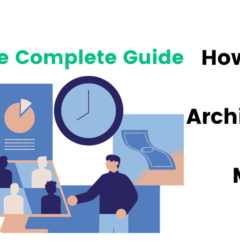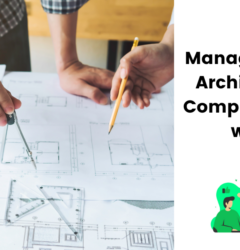How to Ensure Effective Collaboration in Construction Document Reviews
08 Mar
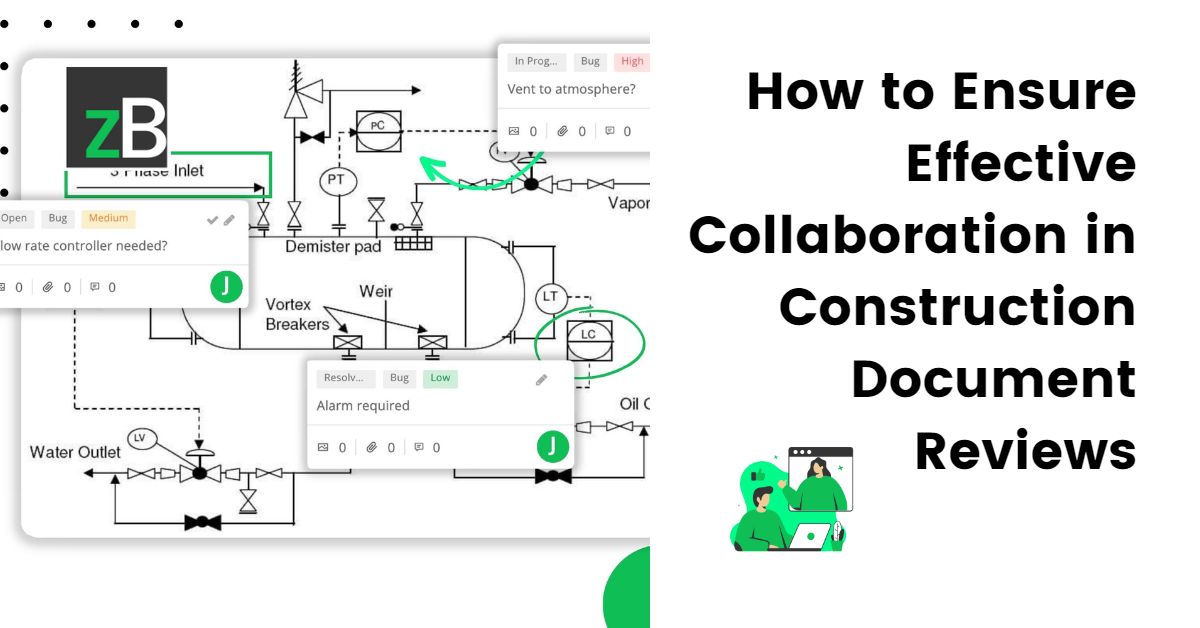
Table of Contents
ToggleThe number of construction documents for a project can vary depending on the scope and complexity of the project, and the time it takes to review these documents can also vary based on the same factors. And ensuring effective collaboration in construction document reviews is key as it streamlines the construction document review process.
It’s worth noting that no matter the number and type of construction documents you have for a project, reviewing the documents ensures that the construction process is devoid of errors and discrepancies, which will help save costs and also mitigate possible risks.
A study by Dodge Data & Analytics on Managing Risk in the Construction Industry showed that increased collaboration is a fundamental strategy for reducing risk in the construction process. 91% of the respondents in the survey for the report agreed with the assertion that collaboration reduces risk.
The types of construction documents you’re likely to review with your stakeholders include drawings, specifications, schedules, contracts, permits and approvals, change orders, shop drawings, submittals, and closeout documents.
Each of these documents may have different requirements for the review and approval process. However, with the right collaboration strategies put in place, you can always review any type of document and foster effective collaboration in your construction document reviews.
Read on to learn more about reviewing construction documents as well as 6 effective strategies to help during the process.
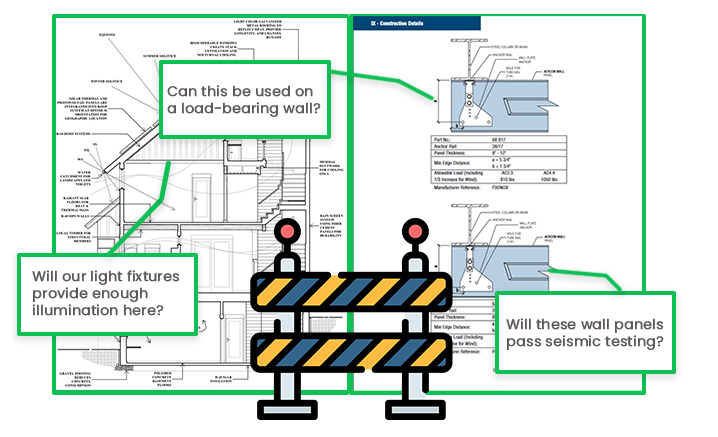
Importance of Conducting Construction Document Reviews
Collaborating on construction document reviews with your architectural team, contractors, project owners, and other stakeholders is important because it ensures that AEC teams design and build projects according to requirements, industry standards, and regulations.
When you conduct effective construction document reviews, you should look forward to enjoying the following.
Quality Assurance
Conducting construction document reviews before the construction process begins ensures that the documents are accurate, complete, and consistent with industry standards and they comply with building codes.
Construction document reviews point you in the right direction and you will know whether the contractors will build the project according to the intended design. This can help improve the quality of the finished project since errors will be detected earlier on and resolved.
Compliance
Construction document reviews help you know whether you are on track and in compliance with building codes, regulations, and industry standards. When you set up construction document reviews, you will be able to fill in the gaps when it comes to meeting requirements, and this will ensure that the project will be legal.
Coordination
Conducting construction document reviews helps ensure that all the stakeholders, including the project owner, design team, and contractor are working in a harmonious and efficient manner toward the common goal. It ensures that all parties are working together and on the same page regarding the document reviews, as well as the entire project.
Cost control
Construction document reviews are important because they help avoid costly changes during construction.
This is because construction documents are usually prone to errors and omissions that can impact the construction process and these documentation errors may only be detected when the document is under review.
So when you review these documents, you will detect the errors early, which will prevent grand changes in the future – this in turn will help save costs and reduce errors.
Time management
When you set up a construction document review, it will ensure that the project is completed on schedule.
Additionally, in the review process, you may identify potential delays or issues early in the project. And this can help the construction team plan and manage the project timeline more effectively.
Risk management
Construction projects can be risky so conducting construction document reviews and following through will help mitigate risks before construction begins.
These reviews also reduce the likelihood of accidents, delays, or other issues that could impact the project’s success. Moreover, you’ll be able to identify likely deficiencies, improve safety, and reduce the risk of accidents and delays during construction.
Communication
Setting up construction document reviews provides an opportunity for effective communication between the design team, construction team, project owners, and other stakeholders.
This helps reduce misunderstandings and conflicts during the construction process – since these misunderstandings will all be tackled and addressed during the review process.
Turn on audio👆
Challenges in Collaborating on Construction Documents
Complexity
Construction documents like drawings, specifications, and calculations, are highly complex and technical. Hence, stakeholders need a certain level of expertise and specialty to be able to review these technical documents.
Coordination
Coordination between multiple design professionals working on different aspects of the documents, as well as reviewers and other stakeholders is difficult.
It’s sometimes difficult to ensure that everyone is on the same page and that all stakeholders are working towards the common good – ensuring that all the different aspects of documents are consistent and coordinate with each other.
One other coordination challenge is dealing with misunderstandings and conflicts between stakeholders concerning the documents for the project.
Schedule constraints
Reviewing construction documents can be time-consuming so it can be difficult to deal with schedules and tight deadlines. And the fear of missing these deadlines may lead to not spending enough time reviewing the documents thoroughly.
However, this will affect the construction process in the long run if you do not resolve errors and discrepancies during the document review process.
Communication
Managing communication between reviewers – construction team, design team, and project owners – can be daunting. You may encounter challenges when scheduling synchronous meetings for stakeholders in different time zones.
How can you get everyone on board at the same time to provide feedback on construction documents via share screen tools like Zoom or Microsoft Teams when some of your stakeholders are in different geographical regions?
Another communication challenge will be dealing with different understandings and misinterpretations of the documents. All in all, you need to ensure that everyone is on the same page to make progress.
Change management
Change management in construction documents can be a headache. There will be aspects of the documents that may have issues and you need to resolve them together with your team.
It’s important that these changes are documented and managed efficiently such that when the architectural/ design team is reviewing the feedback by the other stakeholders, it will be easier to manage the issues and work on them.
Technical issues
During the construction document review process, there may be discrepancies regarding the specifications or conflicts between the drawings and the specifications.
This can be difficult to handle, but you must address and resolve issues or discrepancies to avoid errors and delays during construction.
Document version control
Tracking changes, maintaining consistency, and ensuring all stakeholders are working from the same set of documents can be a burden if you’re not using the appropriate tool to manage your version controls. Confusion will always arise about which document is the most recent and some people may even be reviewing old documents.
Technology limitations
Reviewing paper-based drawings and documents can be time-consuming, error-prone, and difficult to share among stakeholders – especially if you’re a remote or hybrid team.
Architectural teams who do not have access to building information modeling and cloud-based collaboration platforms for documents may find collaborating with their stakeholders very difficult and this can delay the entire project.
Effective Collaboration Strategies for Construction Document Reviews
Use visual aids and give contextualized feedback
Due to the complexity of some construction documents, use visual aids including videos and screenshots to enable stakeholders to give clear feedback. This will make it easier for other reviewers to understand the feedback.
Additionally, giving contextualized feedback on the document itself to prevent different media types like videos, screenshots, etc pinging everywhere is a plus.
When stakeholders give contextualized feedback, it will ensure clarity and make it easier for the architectural team to review the feedback since they will have access to all the environmental details to be able to reproduce the issues.
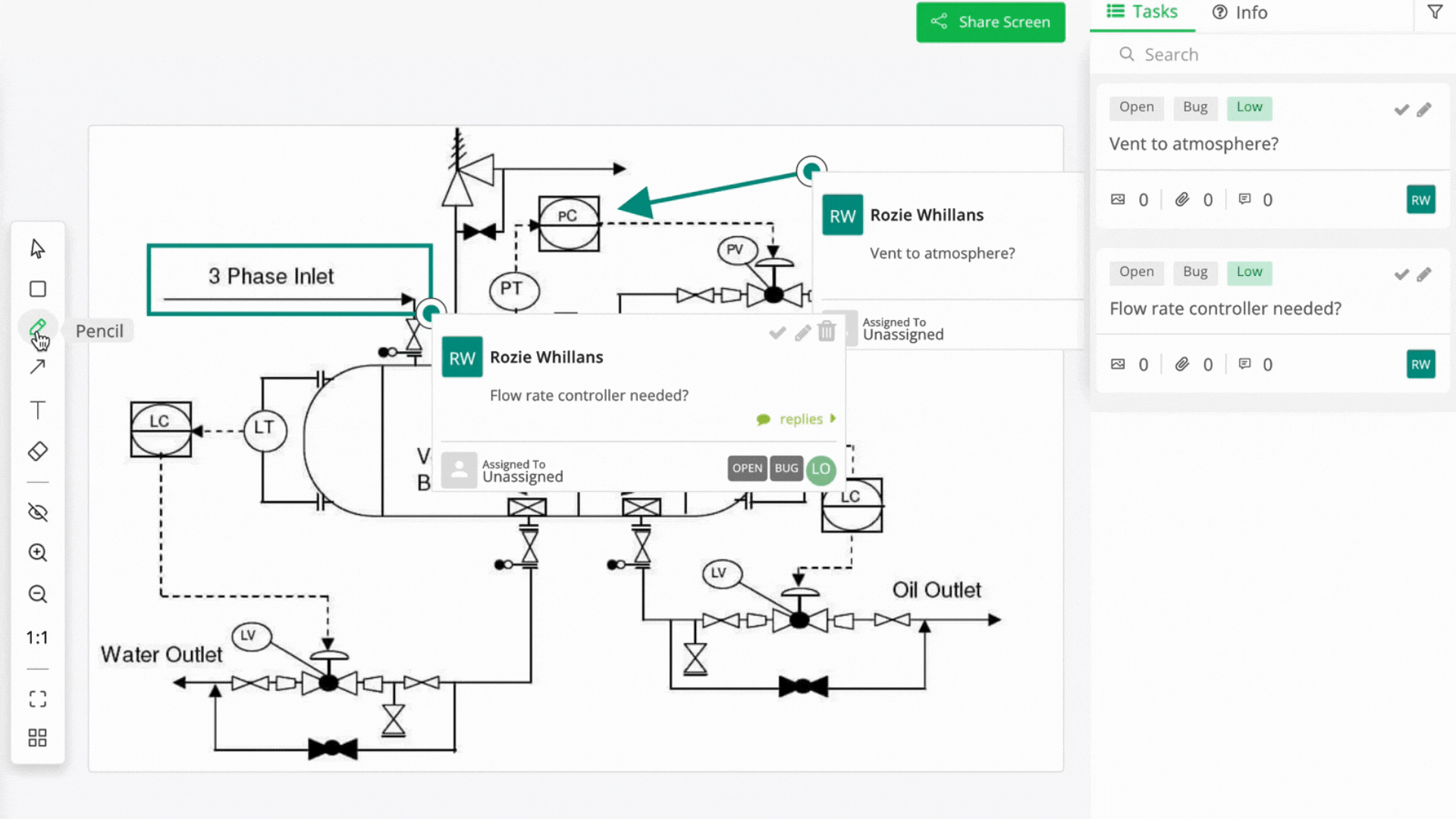
Cloud-based platforms for document approvals with inbuilt features for collaboration will be suitable for this.
An example is zipBoard – a document approval software that allows AEC teams to collaborate on construction documents in one centralized location. It has annotation and screenshot, as well as screen recording features to help reviewers give contextualized feedback in one place.
The good thing is that both internal and external stakeholders can collaborate on projects in the same place so you won’t need different tools for your internal stakeholders and external stakeholders.
Have a streamlined construction document review process
Having an optimized construction document review process will help keep everyone on the same page regarding how the information will be shared, the channels to be used for communication, etc.
A well-defined process will ensure that you meet your goals and also review the document in a more efficient manner, thereby reducing errors and risks and also enhancing quality.
With a streamlined process, all stakeholders will understand the project requirements and how they need to go about reviewing the documents.
Use digital tools
Using digital mark-up tools in your construction document review process will help reduce the risk of errors, improve communication, and ensure that you get feedback in a centralized location. This helps save time and a lot of paperwork.
Digital tools like document approval software, project management software and document management software will help you track changes, comments, and feedback in real-time. They will also help you to deal with document version control issues.
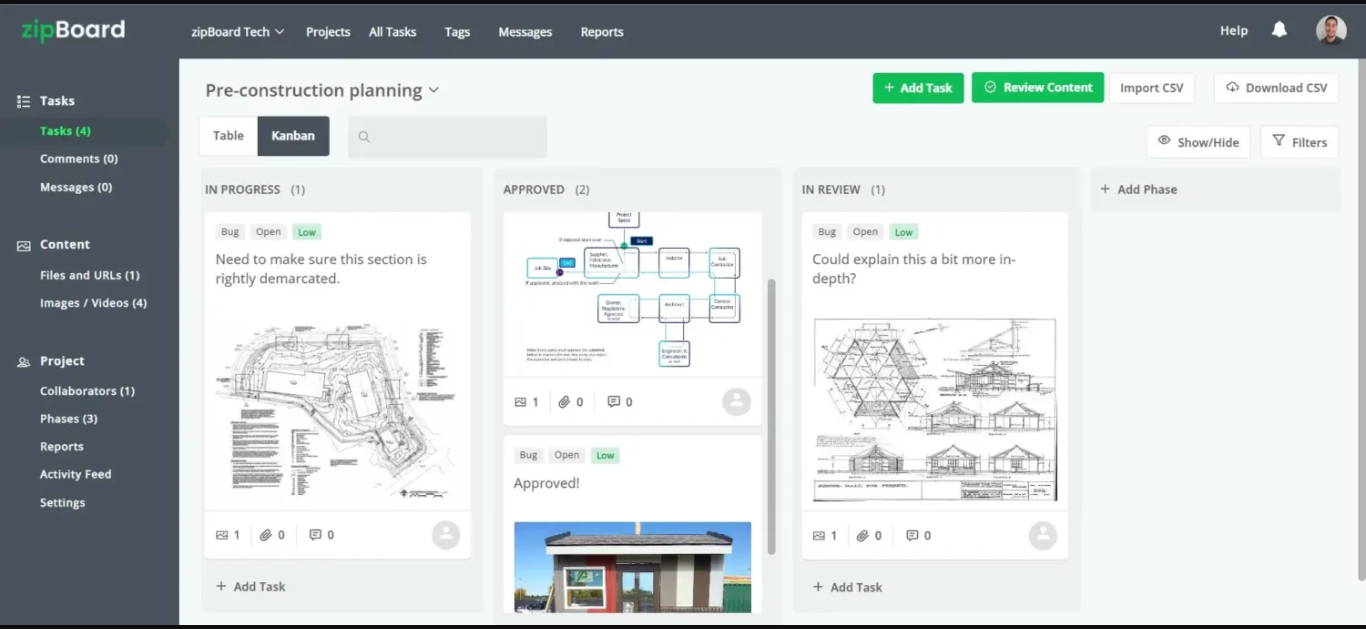

Note: There are different types of digital tools like cloud-based platforms, document management systems, and video conferencing tools, among others that can help you and your team collaborate effectively on construction document reviews. More on that in the next section!
[Datasheet]
Legacy Document Management & Collaboration Software Replacement
Grab your free copy to learn why it's crucial to replace your legacy DMS and collaboration software with zipBoard to improve efficiency
DownloadTrain and educate stakeholders
Provide training for your stakeholders on how the document review process will be done and how the collaboration tools will be used.
Most cloud-based platforms have onboarding processes, which are simple to follow, so you can share a video with your construction team to learn how to use these tools ahead of time.
Also, educate them on the best practices to ensure a successful document review process, as well as key terms and vocabulary to be used so that everyone is on the same page.
Set realistic timelines
When you’re dealing with tight deadlines, you may be forced to set unrealistic timelines and this will affect the quality of the documents and the construction process. So avoid this by setting realistic timelines, and ask for extensions if possible.
This will help you factor in emergencies, unforeseen changes, the complexity of the project, and the availability of stakeholders.
Encourage asynchronous collaboration
When reviewing construction documents the manual way, you may be forced to always schedule meetings and calls to ensure that everyone is on the same page.
However, synchronous meetings and communications may not always be possible and feasible especially if all your stakeholders are not in the same geographical location.
The best way to go is to encourage and foster asynchronous collaboration between the internal and external stakeholders reviewing the construction documents.
With this, all stakeholders can review the documents at the time that’s most convenient for them. Once timelines and deadlines are given, you would not have to worry about deadlines not being met.
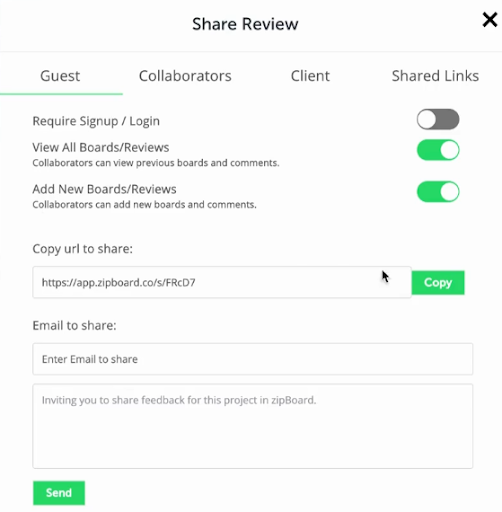
Construction Document Review Tools to Ensure Effective Collaboration
You may not need to use all of these tools. But once you know the documents you’re going to review and the scope of the project, it can guide you in selecting the appropriate tool to aid in your construction document review process.
Cloud-based collaboration platforms
Cloud-based collaboration platforms for construction documents help AEC teams to collaborate and manage construction documents more efficiently.
These tools have a centralized platform for storing and sharing construction documents. They allow stakeholders to access and collaborate on the documents from anywhere, at any time and collaborate in real-time using features like markup tools, commenting, screenshot and annotate, screen recording, and version control, among others.
Examples of such platforms include zipBoard, Autodesk, Bluebeam, or Procore.
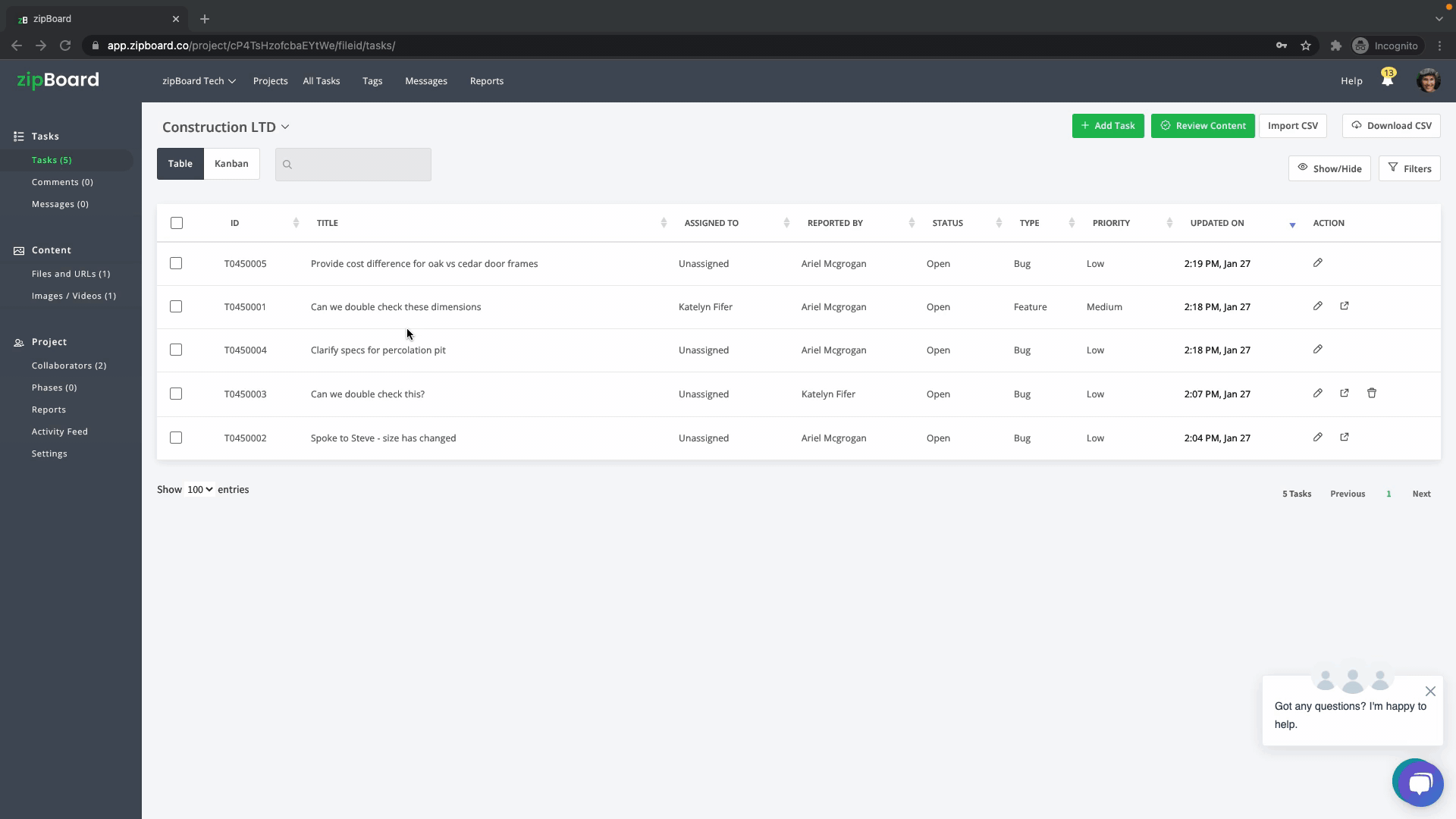
Virtual design and construction (VDC) tools
VDC tools are a type of technology that allows AEC teams to visualize and collaborate on construction projects including plan building designs, processes, schedules, budgets, and other construction documents in 3D.
This helps replicate the construction process. It also helps identify and resolve potential conflicts before construction begins. An example of a VDC technology is the Building Information Modeling (BIM) software.
Electronic plan review software
An electronic plan review software is a tool for AEC teams that helps streamline the review process of construction plans and other documents like specifications and drawings by automating the construction document review and approval process.
This software tracks the status of each plan document and allows stakeholders to markup and annotate PDFs of construction documents.
Examples of electronic plan review software include Bluebeam Revu, PlanGrid, e-PlanSoft, and ViewPoint. It’s worth noting that electronic plan review software is usually used by government agencies, building departments, and other regulatory bodies.
Video conferencing tools
Video conferencing tools are useful for synchronous virtual meetings, which may involve screen sharing. These tools will help all stakeholders collaborate on the document under review in real-time, regardless of their location.
This will also reduce in-person meetings which may be costly if all stakeholders are not in the same geographical region. Examples of such tools include Zoom and Microsoft Teams, which enable stakeholders to participate in virtual meetings, share screens, and collaborate in real time.
Messaging apps
Messaging apps like Microsoft Teams and Slack help AEC teams to collaborate both synchronously and asynchronously. Slack, for instance, has features for document sharing and file sharing.
So when integrated with the appropriate cloud-based platform for construction document reviews, it will help streamline the review process.
The same applies to MS Teams as it also has chat, voice call, and video features, and allows for sharing and reviewing documents. Other messaging tools to consider include Telegram, WhatsApp, and Signal.
Construction document management software
Construction document management software – also known as construction document control software are a type of document management software, just that these are tailored to AEC teams.
This software helps streamline the construction document review process by providing collaboration, version control, document security, and document tracking features.
Examples of construction document management software include zipBoard, Bluebeam Revu, Cloudsfer, DADO, and Autodesk Construction Cloud.
Need a Recommendation?
Try zipBoard – a document review and approval software for AEC teams. It is a great tool for reviewing construction documents since it has mark-up tools, as well as screen recording and screenshot and annotate features that allow stakeholders to give contextualized feedback in one place.
With zipBoard, you can integrate your organization’s construction management or SAP to review your documents directly from your system.
This keeps your construction documents secured, organized and consolidated. You can also integrate your communication and collaboration tools like Slack and MS Teams to share feedback with all stakeholders in one place.
Once this is done, all your issues and reviews will be stored in a centralized location and you won’t have to manage reviews from different platforms.
By integrating zipBoard into our submittal review process we were able to significantly speed up our pre-construction review phase and hit our construction field goals on time.
Wrapping Up
Collaboration in construction document reviews is important to the success of the construction project, and when done right, the review process can help the stakeholders generate relevant insights that can be useful for tracking and improving the construction process.
When you implement the strategies and guidelines given in this article, you will ensure effective collaboration between your stakeholders in the construction document review process and you will also be able to generate data to help you and your entire team make a more informed decision as well as improve the overall efficiency and effectiveness of the construction process.
Below are 5 insights you can get from your construction document review process.
- Review feedback – The feedback you collate during the document review process can be used to identify areas for improvement and to track/ monitor progress over time.
- Review time – The review time will help you identify bottlenecks or inefficiencies in the review process and to track progress in reducing review times.
- Reviewer performance – The feedback you get from all reviewers during the process can help you to identify high-performing reviewers and to provide feedback and training to improve/ enhance the performance of lower-performing reviewers. This will help improve other stages of the review process.
- Issue tracking – The data generated on issues recorded can be used to track progress in addressing issues and to identify recurring issues that may require extra attention.
- Project metrics – The review process can help generate data on project metrics like cost, schedule, and quality. By tracking these metrics over time, the construction team can identify trends and patterns and make data-driven decisions to improve project outcomes.
Ensure Effective Collaboration in Your Next Construction Document Review with zipBoard
Start your free trial or book a demo today so that we can create a tailored solution for you.
Book DemoStart Free TrialAuthor’s bio:
Dorcas Kpabitey is a Content Marketing Specialist at zipBoard. She began her content marketing journey alongside her BA in Political Science and Spanish at the University of Ghana. If she is not tapping away at her keyboard or spending time on Twitter and LinkedIn, she spends her day reading articles, newsletters and books.
Recent Posts
- How Laerdal Medical Cut eLearning Review Time by 50% with zipBoard’s Visual Review Tool July 9, 2025
- Why Your Team Needs a Content Feedback System (Not Just Comments in Docs) May 28, 2025
- Content Approvals Are Slowing You Down — Here’s the Fix May 26, 2025
- How to Streamline Content Review and Approval — Best Practices, Tools & Automation May 12, 2025
- What Is Content Operations? And Why It Breaks Without a Feedback & Approval System May 3, 2025
©️ Copyright 2023 zipBoard Tech. All rights reserved.
